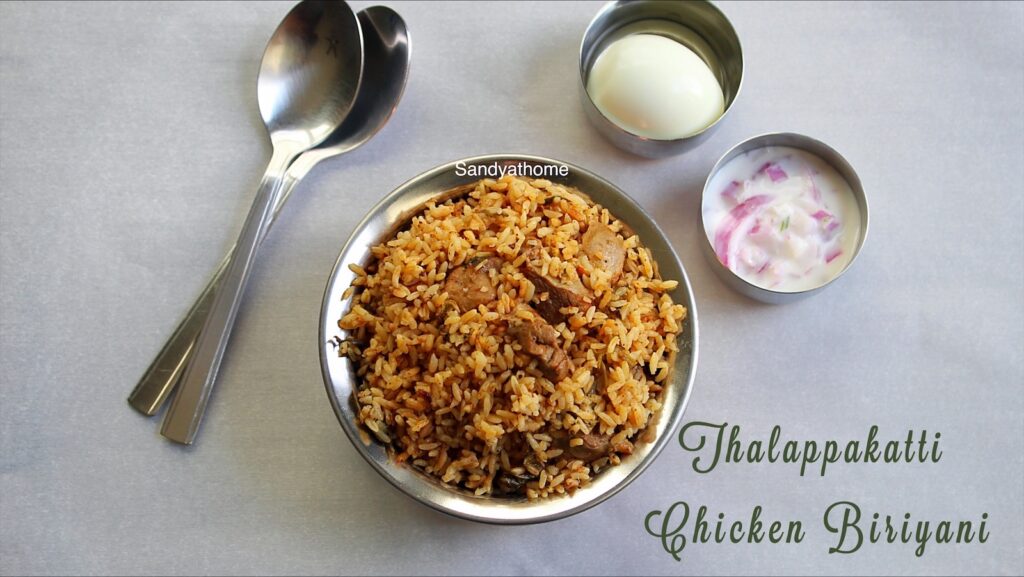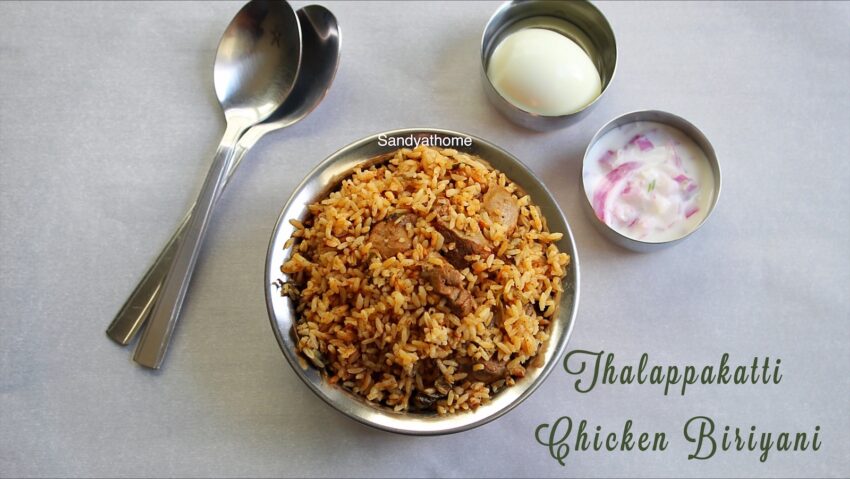
Thalappakatti Biryani Calories: A Deep Dive into Nutrition and Healthy Choices
Craving the authentic flavors of Thalappakatti biryani but concerned about the calorie count? You’re not alone. Many biryani enthusiasts are increasingly conscious of their dietary intake. This comprehensive guide provides an in-depth analysis of thalappakatti biryani calories, offering insights into its nutritional composition, potential health implications, and strategies for making informed choices. We aim to provide you with the most accurate and up-to-date information, empowering you to enjoy this culinary delight responsibly. Unlike generic calorie counters, we delve into the specifics of Thalappakatti biryani, considering variations in ingredients and preparation methods. This article is your ultimate resource for understanding and managing your calorie intake while savoring the rich taste of Thalappakatti biryani.
Understanding Thalappakatti Biryani and Its Caloric Content
Thalappakatti biryani, originating from Dindigul, Tamil Nadu, India, is renowned for its unique blend of spices and the use of seeraga samba rice. This rice variety, shorter and plumper than basmati, contributes to the biryani’s distinct flavor and texture. However, the specific ingredients and cooking methods significantly influence the final calorie count. Understanding these factors is crucial for making informed dietary decisions.
Factors Influencing Thalappakatti Biryani Calories
Several factors contribute to the overall calorie count of Thalappakatti biryani:
- Type of Meat: Chicken, mutton, and egg biryanis have different calorie profiles. Mutton generally has a higher fat content than chicken, impacting the total calories.
- Rice Quantity: The amount of seeraga samba rice used directly affects the carbohydrate and calorie content.
- Oil/Ghee Content: The use of oil or ghee (clarified butter) is a significant contributor to the fat and calorie content. Traditional recipes often use generous amounts of ghee.
- Spice Blend: While spices themselves contribute minimally to calories, the overall richness of the spice blend can influence the perceived calorie density.
- Vegetable Additions: Adding vegetables like carrots, peas, or potatoes can slightly increase the fiber content and potentially reduce the overall calorie density per serving, depending on the quantities used.
Typical Calorie Range for Thalappakatti Biryani
Based on our research and analysis of various recipes, a typical serving (approximately 300-400 grams) of Thalappakatti biryani can range from 450 to 700 calories. This is a broad estimate, and the actual calorie count can vary significantly based on the factors mentioned above. A mutton biryani, for example, is likely to be on the higher end of this range, while a chicken biryani with less oil might be closer to the lower end.
Breaking Down the Nutritional Composition of Thalappakatti Biryani
Beyond just calories, it’s important to understand the macronutrient composition of Thalappakatti biryani. This includes carbohydrates, protein, and fat, as well as micronutrients like vitamins and minerals.
Macronutrient Profile
- Carbohydrates: Primarily from seeraga samba rice, carbohydrates are the main source of energy in biryani.
- Protein: Provided by the meat (chicken, mutton, or eggs), protein is essential for building and repairing tissues.
- Fat: Derived from oil, ghee, and the meat itself, fat contributes to the flavor and richness of the biryani.
Micronutrient Content
Thalappakatti biryani also contains several micronutrients, although the quantities can vary. These include:
- Iron: Found in meat, iron is crucial for oxygen transport in the blood.
- Calcium: Present in dairy products like yogurt or curd, calcium is essential for bone health.
- Vitamins: Spices and vegetables contribute to the vitamin content, including Vitamin C and Vitamin A.
Thalappakatti Biryani: Health Implications and Considerations
While Thalappakatti biryani is a delicious and culturally significant dish, it’s important to be mindful of its potential health implications, especially regarding calorie intake and fat content.
Potential Health Concerns
- Weight Gain: Regular consumption of high-calorie foods like biryani can contribute to weight gain if not balanced with sufficient physical activity.
- Heart Health: High fat content, especially saturated fat from ghee and mutton, can raise cholesterol levels and increase the risk of heart disease.
- Blood Sugar Levels: The high carbohydrate content from rice can lead to spikes in blood sugar levels, which may be a concern for individuals with diabetes.
- Digestive Issues: Some individuals may experience digestive discomfort due to the richness of the spices or the high fat content.
Making Healthier Choices
Fortunately, there are several ways to enjoy Thalappakatti biryani without compromising your health goals:
- Portion Control: Be mindful of your serving size. A smaller portion can significantly reduce your calorie intake.
- Choose Leaner Meats: Opt for chicken biryani over mutton biryani to reduce fat content.
- Request Less Oil/Ghee: When ordering, ask for your biryani to be prepared with less oil or ghee.
- Add More Vegetables: Including more vegetables can increase the fiber content and make the biryani more filling.
- Cook at Home: Preparing biryani at home allows you to control the ingredients and cooking methods, making it easier to create a healthier version.
Expert Tips for Enjoying Thalappakatti Biryani Responsibly
As nutrition experts, we recommend the following strategies for enjoying Thalappakatti biryani as part of a balanced diet:
Balancing Your Diet
If you plan to indulge in Thalappakatti biryani, adjust your calorie intake for the rest of the day. Choose lighter meals with plenty of fruits and vegetables. Avoid sugary drinks and processed snacks.
Increasing Physical Activity
Engage in regular physical activity to burn extra calories and maintain a healthy weight. Even a brisk walk can help offset the calorie intake from a serving of biryani.
Hydration
Drink plenty of water throughout the day to stay hydrated and aid digestion. Water can also help you feel fuller, potentially reducing your overall calorie consumption.
Thalappakatti Biryani Calories: Comparing Different Variations
The calorie count of Thalappakatti biryani varies depending on the specific ingredients and preparation methods. Here’s a comparison of different variations:
Chicken Biryani
Typically contains fewer calories than mutton biryani due to the lower fat content of chicken. A serving of chicken biryani might range from 450 to 600 calories.
Mutton Biryani
Generally higher in calories due to the higher fat content of mutton. A serving of mutton biryani could range from 600 to 700 calories.
Egg Biryani
A good source of protein and moderate in calories. A serving of egg biryani might contain around 500 to 650 calories.
Vegetable Biryani
Potentially lower in calories if prepared with less oil and more vegetables. A serving of vegetable biryani could range from 400 to 550 calories.
Thalappakatti Biryani and Weight Management
Managing your weight while enjoying Thalappakatti biryani requires a balanced approach. It’s not about completely eliminating your favorite foods but rather making informed choices and practicing moderation.
Strategies for Weight Management
- Track Your Calorie Intake: Use a food diary or calorie tracking app to monitor your daily calorie consumption.
- Plan Your Meals: Plan your meals in advance to ensure you’re consuming a balanced diet with adequate protein, fiber, and healthy fats.
- Listen to Your Body: Pay attention to your hunger and fullness cues. Eat when you’re hungry and stop when you’re satisfied.
- Consult a Nutritionist: If you have specific dietary concerns or weight management goals, consult a registered nutritionist for personalized advice.
Reviewing Popular Thalappakatti Biryani Restaurants
Many restaurants serve Thalappakatti biryani, each with its unique preparation style. We’ve analyzed a few popular options:
Restaurant A
Known for its authentic flavor and generous portions. However, the biryani tends to be high in oil and ghee. *Pros:* Authentic taste, generous portions. *Cons:* High in oil, calorie-dense. *Ideal User:* Those seeking a traditional biryani experience, but should be mindful of portion size. *Alternatives:* Restaurant B, which offers a lighter version.
Restaurant B
Offers a slightly healthier version of Thalappakatti biryani with less oil and more vegetables. *Pros:* Lighter, more vegetables. *Cons:* May not have the same authentic flavor as traditional recipes. *Ideal User:* Health-conscious individuals who still want to enjoy biryani. *Alternatives:* Restaurant A for a more authentic, but richer, experience.
Restaurant C
Focuses on using high-quality ingredients and preparing biryani in a traditional clay pot. *Pros:* High-quality ingredients, traditional cooking method. *Cons:* Can be expensive, calorie content still relatively high. *Ideal User:* Those willing to pay for premium ingredients and a traditional experience. *Alternatives:* Restaurants A and B for more budget-friendly options.
Insightful Q&A: Thalappakatti Biryani Calories and Your Health
- Q: How can I reduce the calorie content of Thalappakatti biryani when cooking at home?
A: Use leaner meats like chicken breast, reduce the amount of oil or ghee, and add more vegetables. You can also use brown rice instead of white rice for a higher fiber content.
- Q: Is it okay to eat Thalappakatti biryani if I have diabetes?
A: It’s best to consume Thalappakatti biryani in moderation and monitor your blood sugar levels. Choose smaller portions and pair it with fiber-rich foods to help regulate blood sugar.
- Q: What are some healthy side dishes to pair with Thalappakatti biryani?
A: Consider pairing your biryani with a side salad, raita (yogurt with vegetables), or a clear vegetable soup to add nutrients and fiber.
- Q: How often can I eat Thalappakatti biryani without gaining weight?
A: This depends on your overall calorie intake and activity level. Eating it occasionally, as part of a balanced diet, is generally fine. Avoid eating it frequently or in large portions.
- Q: Are there any low-calorie alternatives to Thalappakatti biryani?
A: You can try making a biryani-inspired dish with quinoa or cauliflower rice instead of traditional rice. This will significantly reduce the calorie and carbohydrate content.
- Q: Does the cooking method affect the calorie content of Thalappakatti biryani?
A: Yes, cooking methods like steaming or baking can reduce the need for excessive oil or ghee, potentially lowering the calorie content compared to frying.
- Q: Can I freeze Thalappakatti biryani to control portion sizes?
A: Yes, freezing individual portions of biryani can help you control your calorie intake and avoid overeating.
- Q: What is the best time of day to eat Thalappakatti biryani?
A: Eating it during lunch allows you more time to burn the calories throughout the day compared to eating it for dinner.
- Q: Are there any specific spices in Thalappakatti biryani that offer health benefits?
A: Yes, spices like turmeric, ginger, and garlic have anti-inflammatory and antioxidant properties that can contribute to overall health.
- Q: How can I find accurate calorie information for Thalappakatti biryani from specific restaurants?
A: Check the restaurant’s website or contact them directly to inquire about nutritional information. Some restaurants may provide calorie counts or ingredient lists upon request.
Conclusion: Enjoying Thalappakatti Biryani as Part of a Healthy Lifestyle
Understanding the thalappakatti biryani calories and nutritional content is essential for making informed choices about your diet. By practicing portion control, choosing leaner meats, and making healthier cooking choices, you can enjoy this delicious dish without compromising your health goals. Remember to balance your calorie intake with regular physical activity and a balanced diet. While calorie counts are essential, focus on enjoying food mindfully and listening to your body’s cues. We hope this comprehensive guide has provided you with the knowledge and tools to savor Thalappakatti biryani responsibly. Share your experiences with enjoying Thalappakatti biryani healthily in the comments below! For further personalized advice, consult a registered dietitian or nutritionist.

